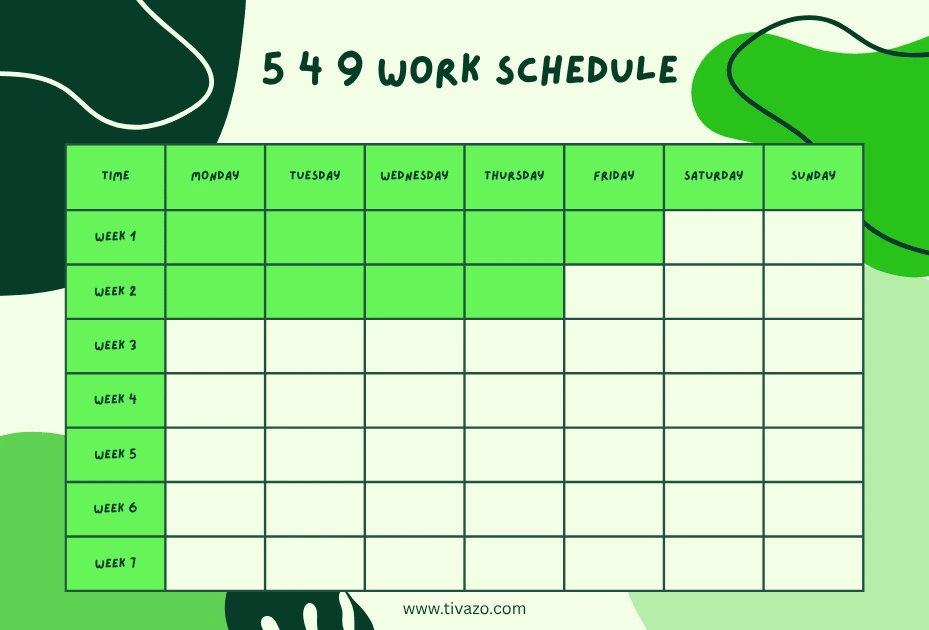Feeling as though working from 9 to 5 doesn’t suit your life anymore? There are other people in the same situation. More people working in the professions now choose alternative work schedules to have more time for their personal lives. That’s where 5 4 9 work schedules come in. 5 4 9 work schedules are gaining a lot of serious interest these days. Why is it being described as a game-changer for those in the workforce now?
We will explain in detail the 5 4 9 work schedule, such as how it operates, what its benefits are, the things that might not work for you, and whether it is right for you or your workplace.
Key Highlights:
- How Does the 5 4 9 Schedule Work?
- Benefits of the 5 4 9 Work Schedule
- Challenges of the 5 4 9 Work Schedule
- Who Should Consider a 5 4 9 Work Schedule?
- How to Pitch a 5 4 9 Work Schedule to Your Boss
- Difference between 5/4/9 and 4 10 Work Schedule
- Tips for Managing Energy and Focus During Longer Workdays
What is the 5 4 9 Work Schedule?
The 5 4 9 work schedule is a form of compressed workweek that allows employees to work their usual 80-hour biweekly schedule in nine days instead of ten. The structure looks like this:
- Week 1: Work 9 hours a day for 5 days
- Week 2: Work 9 hours a day for 4 days and take the 5th day off
This means employees get one full day off every other week while still putting in the required hours. The 5 4 9 work schedule is commonly used in government agencies, corporate offices, and companies that value flexible scheduling.
How Does the 5 4 9 Schedule Actually Work?
The 5 4 9 work schedule is a compressed work schedule that spreads 80 working hours across a two-week pay period — just like a traditional 9-to-5 job — but in a smarter, more flexible way. Instead of working 8 hours a day for 10 days straight, employees work nine hours a day for eight days, one eight-hour day, and then get one full day off every other week. This means you’re still putting in the same number of hours, but you’re gaining one extra day off every two weeks, without using any vacation time.
Sounds good, right? Let’s break it down clearly:
You May Also Like: Conquering the 80 Hours a Week: Proven Strategies for Success and Well-being
Week-by-Week Breakdown of the 5 4 9 Work Schedule
| Week | Days Worked | Hours Per Day | Total Hours |
| Week 1 | Mon to Thu | 9 hours | 36 hours |
| Friday | 8 hours | 8 hours | |
| Total | 44 hours | ||
| Week 2 | Mon to Thu | 9 hours | 36 hours |
| Friday | OFF | 0 hours | |
| Total | 36 hours | ||
| Total (2 Weeks) | 80 hours |
So, instead of five 8-hour workdays each week, the 5 4 9 work schedule gives you a rhythm of working longer days (but fewer of them), helping you earn that bonus day off every other Friday.
Think of It Like This:
Imagine working just nine hours a day — one extra hour than usual — but getting a three-day weekend every other week. That extra day can be used to recharge, run errands, travel, or just relax at home. You don’t lose any pay, and your total hours remain the same. It’s a win-win!
10 Incredible Benefits of the 5 4 9 Work Schedule

The 5 4 9 work schedule isn’t just a trend—it’s quickly becoming the secret weapon of modern professionals seeking better balance, improved productivity, and a more fulfilling life. This unique compressed schedule brings benefits for both employees and employers that go far beyond just one extra day off.
1. More Time for Life
A big positive of the 5 4 9 schedule is being able to use your time more wisely. Having a day off every two weeks gives people time to relax, take care of themselves, or take a quick trip.
Having flexibility over how you work helps you enjoy a better balance between your job and personal life. Being able to control your days helps you in healthcare visits, with family, or when relaxing.
2. Enhanced Work-Life Balance
When people increase the amount of time they work in one day and rest on other days, it helps them manage work and personal life better. This method is highly successful at preventing burnout from daily work.
Having a work schedule of 5 4 9 enables employees to take a break and unwind more often, which boosts everyone’s mood and dedication. Both a person’s mental health and job success improve from that.
3. Fewer Commutes
Daily schedules stay the same, but two days of not commuting multiple times a week can make a big difference. Hybrid cars help you use less petrol, have less wear, and save your time the most.
People working remotely or hybrid enjoy this benefit as the flexible days help them rest their eyes from too much digital activity. This gain promotes not only using eco-friendly practices but also makes employees feel satisfied.
4. Increased Productivity
Having a long, continuous work period usually leads to better focus and more results. Employees have the freedom to handle big responsibilities without being limited by standard work hours.
Working this way helps professionals handle more creative or challenging projects. Reducing context switches allows you to achieve more important work.
5. Higher Employee Satisfaction
Being treated with respect for your time greatly affects how staff feel and see their work. It shows staff that the company trusts their capabilities.
A happy staff is more likely to remain with the company, work hard and do more for their customers. It directly helps employees perform better and stay on the job for a longer period.
6. Reduced Burnout
Rest gives your body and mind a chance to rest and regenerate. More people say that flexible work makes them feel less tired and more attentive while on the job.
Taking a longer weekend every other week makes chronic stress less likely. So, the 5 4 9 model plays a significant role in promoting employees’ well-being.
Read More: Digital Detox: 7 Powerful Steps to Boost Focus & Joy!
7. Cost Savings
Working from home enables people to save on both trips to work and eating out, as well as sometimes childcare costs for parents. Saving regularly allows those balances to grow over the years.
Employers gain as well—content employees have lower sickness and tend to stay longer with the company. Both companies and customers find it friendly to their budgets.
8. Boosted Team Efficiency
Being away from meetings and classes makes teams adjust how they work to make the best use of time. There is less time spent in meetings, planning is more efficient and team members work more closely together.
With this structure, staff are guided to be laser-focused, stay together, and work for strong outcomes. It is not direct but helps employees keep up their efforts.
9. Powerful Recruiting Tool
Having a 5 4 9 work schedule gives employers a benefit in recruitment efforts. Job applicants prefer job openings where they can have a flexible or compressed work schedule.
Such a benefit demonstrates concern for workers’ well-being which can really matter to potential top performers.
10. Positive Company Culture
Offering flexibility at work builds a company culture based on trust, respect and independence. Letting employees control their own time shows trust which in turn boosts morale and makes them more loyal.
With continued small changes, a workplace’s identity gets stronger. This pattern of work goes beyond being a comfortable benefit; it affects our thinking daily.
Because time is so important in our busy lives, the 5 4 9 work schedule provides the kind of flexibility that workers ask for.
It allows people to be productive at work and still make the most of their lives which is what the future work environment should be.
Common Challenges of the 5 4 9 Work Schedule

While the 5 4 9 work schedule offers many benefits, it’s not a one-size-fits-all solution. Like any flexible work arrangement, it comes with its own set of challenges that employees and employers should be aware of before committing.
1. Longer Days Can Be Draining
The schedule and the demands of the work can result in workers feeling tired after a day of nine-hour shifts. Having a longer workday needs better time planning, regular rest, and discipline to keep from overworking.
2. Coordination Issues Across Teams
Not all departments following the same hours can cause tension during teamwork. Getting all team members present at meetings may get harder and schedules might get messed up when important staff has different Fridays off.
3. Not Ideal for Customer-Facing Roles
Positions that are always needed, for example in customer service or front desk work, may not fit well with 5 4 9. Shortened work schedules might reduce the service people can get which could affect their satisfaction.
4. Childcare and Family Schedule Conflicts
Having a schedule that goes late in the day might not suit parents who have to take care of their kids after school. It is not always easy for single parents or parents of young kids to schedule work so that it matches daycare or school hours.
Despite the problems, a lot of professionals feel the benefits outweigh the difficulties.
Setting clear expectations and preparing in advance usually allows most of these problems to be handled well, so many people see this as an excellent schedule.
Who Should Consider a 5 4 9 Work Schedule?
This flexible work format is ideal for:
- Office workers with project-based tasks
- Remote workers who manage their own time
- Teams with shared responsibilities
- Government employees and federal workers
If you value work-life balance, the 5 4 9 work schedule might be exactly what you need.
How to Pitch a 5 4 9 Work Schedule to Your Boss
Want to suggest working on a 5 4 9 schedule to your boss? Show that you’ve learned about remote work—explain how it boosts productivity and benefits, and mention businesses that have tried it. Offer colleagues a chance to test the platform for about a month to understand it better. Assure them you are open to hearing feedback and are able to adjust if needed. Especially, prepare a basic plan letting them know how you can keep working without a glitch.
Setting Up a 5 4 9 Schedule for Teams
For teams, implementing a 5 4 9 work schedule requires careful coordination. Here’s what managers should consider:
- Assign alternating Fridays off to ensure coverage
- Use time-tracking tools to monitor hours
- Create clear communication guidelines
- Encourage feedback from the team regularly
A well-structured rollout leads to better adoption and results.
Real-Life Success Stories Using the 5 4 9 Work Schedule
The dev team at a lively tech startup in Austin was overwhelmed by the many deadlines they faced. The last effort to encourage morale among the staff was the 5 4 9 schedules. At first, managers were uncertain and tried it out. After several weeks, the code was improved, issues were removed more quickly, and everyone was not chatting on Slack after work. Naturally, Fridays off became days for working on personal interests. The vibe? Electric. As a result, it’s more than a plan; it’s what brings out the happiness and productivity in their team.
5 4 9 vs. 4 10 Work Schedule: What’s the Difference?
When it comes to compressed work schedules, the 5 4 9 work schedule and the 4 10 schedule are two popular options. Both offer extended weekends, but they differ in how hours and days are structured, making each suitable for different work styles and needs.
| Feature | 5 4 9 Work Schedule | 4 10 Work Schedule |
| Workdays Per 2 Weeks | 9 | 8 |
| Hours Per Day | 9 | 10 |
| Day Off | 1 day off every other week (usually Friday) | 1 day off every week (usually Friday) |
| Total Hours Per Pay Period | 80 hours | 80 hours |
| Work-Life Balance | Balanced with slightly longer days | More intense workdays, but a weekly long weekend |
| Common in | Federal agencies, flexible teams | Industries needing weekly downtime |
| Best For | Employees prefer routine with a balance | Employees who enjoy longer weekends |
Both schedules have their perks—it really depends on your energy levels and lifestyle. If you’re after consistency with a regular rhythm, 5 4 9 may be your best bet; if longer weekends sound dreamy and you can handle 10-hour days, 4 10 might be the winner.
Tools to Manage a 5 4 9 Work Schedule Effectively
To truly thrive on a 5 4 9 work schedule, the right tools can make all the difference. Managing longer workdays and a shifting weekly routine gets easier when your planning and productivity tools are dialed in.
1. Google Calendar or Outlook
Making use of Google Calendar or Microsoft Outlook is a good way to clearly arrange your biweekly schedule. It helps to mark out your workdays, organize your empty Fridays, and manage your calendar, which will help you stay alert to meetings or deadlines and avoid being caught off-guard.
2. Time-Tracking Apps

You can track your time with tools like Tivazo on the longer workdays that a 5 4 9 schedule offers. They let you check your productivity, make sure you don’t overstrain yourself, and see how your time is used during the shortened schedule.
3. Task Managers
Using Asana, Trello, or ClickUp can guide you in sorting your to-dos for entire workdays. If you arrange your projects carefully and set reasonable goals, you can work without feeling overwhelmed, which helps make your tight schedule go smoothly and efficiently.
Ensuring you have helpful tools allows you to save time, feel less stressed, and really make the most of working on a 5 4 9 schedule. When you have improved sight of your tasks, time, and goals, you will keep achieving them week after week.
Tips for Managing Energy and Focus During Longer Workdays
Working longer hours each day, as with the 5 4 9 work schedule, can be challenging if you don’t manage your energy and focus properly. To make the most of those 9-hour days without burning out, try these effective strategies:
1. Prioritize Breaks with the Pomodoro Technique
Instead of working for hours at a time, try doing short bursts of focused effort for 25 minutes, then pausing for 5 minutes. After going through four different cycles, take a break for 15–30 minutes. The breaks are important for your mental wellness and make you less likely to get tired.
You May Also Like: Pomodoro Technique For Work: Reason To Use, How To Do It
2. Stay Hydrated and Eat Balanced Meals
Balanced energy levels require that your brain and body be fueled. Keep yourself hydrated with water and pick dishes and snacks with protein, healthy fats, and complex carbohydrates. Refrain from eating too many heavy meals and cut down on sugary foods to prevent having trouble with energy.
3. Create a Morning Routine to Kickstart Focus
Try to begin your day with an activity that motivates you, such as exercising, meditating, or having a healthy breakfast. If you set a good mood from the start, your mind is better placed to keep working for a longer stretch without distraction.
When you use these tips every day, working extra hours on the 5 4 9 schedule becomes easier.
Read More: Morning Routine and a Morning Routine Checklist
Conclusion
If you’re looking for a practical way to boost work-life balance without sacrificing productivity, the 5 4 9 work schedule might be your solution. It’s a simple yet powerful change that brings more freedom, focus, and fulfillment to your work routine.
With the right planning, communication, and mindset, this schedule can transform how you work and live.
How to work 4 to 10 hour days?
Focus on time management, take regular breaks, and prioritize tasks to stay productive during longer 10-hour workdays.
How to survive 4 12-hour shifts?
Get plenty of rest, stay hydrated, eat well, and take short breaks to maintain energy during long 12-hour shifts.
Can I work 40 hours in 4 days?
Yes, working four 10-hour days equals 40 hours, giving you an extra day off each week with proper planning.




